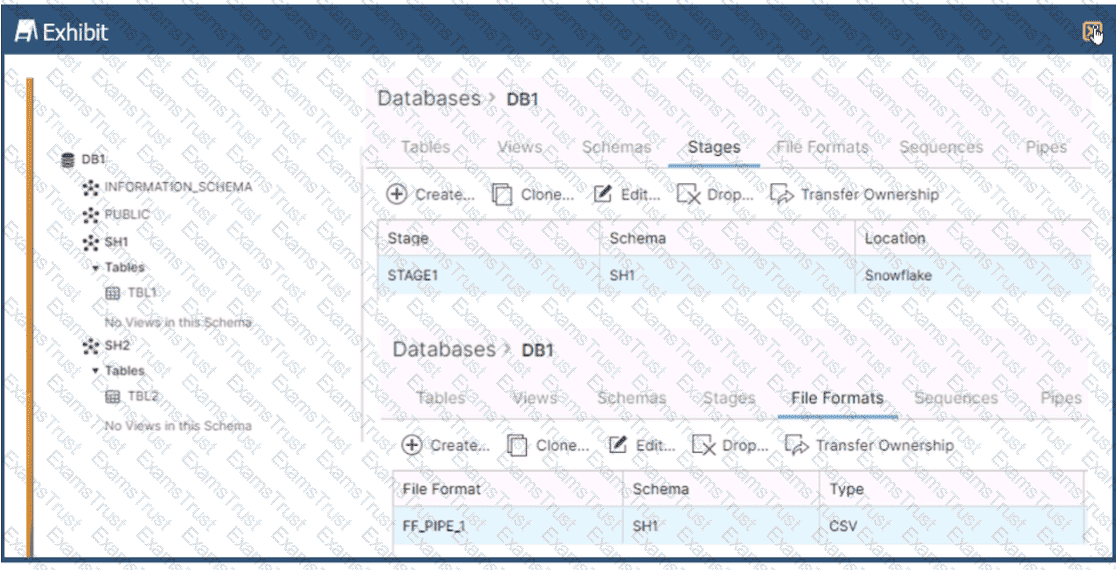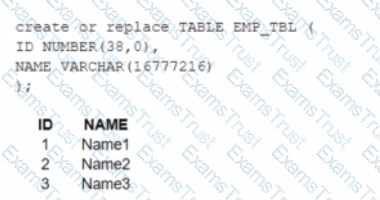Which of the below commands will use warehouse credits?
What integration object should be used to place restrictions on where data may be exported?
An Architect has designed a data pipeline that Is receiving small CSV files from multiple sources. All of the files are landing in one location. Specific files are filtered for loading into Snowflake tables using the copy command. The loading performance is poor.
What changes can be made to Improve the data loading performance?
A table contains five columns and it has millions of records. The cardinality distribution of the columns is shown below:

Column C4 and C5 are mostly used by SELECT queries in the GROUP BY and ORDER BY clauses. Whereas columns C1, C2 and C3 are heavily used in filter and join conditions of SELECT queries.
The Architect must design a clustering key for this table to improve the query performance.
Based on Snowflake recommendations, how should the clustering key columns be ordered while defining the multi-column clustering key?
A company has a table with that has corrupted data, named Data. The company wants to recover the data as it was 5 minutes ago using cloning and Time Travel.
What command will accomplish this?
An Architect needs to improve the performance of reports that pull data from multiple Snowflake tables, join, and then aggregate the data. Users access the reports using several dashboards. There are performance issues on Monday mornings between 9:00am-11:00am when many users check the sales reports.
The size of the group has increased from 4 to 8 users. Waiting times to refresh the dashboards has increased significantly. Currently this workload is being served by a virtual warehouse with the following parameters:
AUTO-RESUME = TRUE AUTO_SUSPEND = 60 SIZE = Medium
What is the MOST cost-effective way to increase the availability of the reports?
Which Snowflake objects can be used in a data share? (Select TWO).
An Architect is using SnowCD to investigate a connectivity issue.
Which system function will provide a list of endpoints that the network must be able to access to use a specific Snowflake account, leveraging private connectivity?
Assuming all Snowflake accounts are using an Enterprise edition or higher, in which development and testing scenarios would be copying of data be required, and zero-copy cloning not be suitable? (Select TWO).
An Architect runs the following SQL query:

How can this query be interpreted?
Consider the following scenario where a masking policy is applied on the CREDICARDND column of the CREDITCARDINFO table. The masking policy definition Is as follows:

Sample data for the CREDITCARDINFO table is as follows:
NAME EXPIRYDATE CREDITCARDNO
JOHN DOE 2022-07-23 4321 5678 9012 1234
if the Snowflake system rotes have not been granted any additional roles, what will be the result?

Based on the architecture in the image, how can the data from DB1 be copied into TBL2? (Select TWO).
A)

B)

C)

D)

E)

An Architect clones a database and all of its objects, including tasks. After the cloning, the tasks stop running.
Why is this occurring?
Based on the Snowflake object hierarchy, what securable objects belong directly to a Snowflake account? (Select THREE).
Role A has the following permissions:
. USAGE on db1
. USAGE and CREATE VIEW on schemal in db1
. SELECT on tablel in schemal
Role B has the following permissions:
. USAGE on db2
. USAGE and CREATE VIEW on schema2 in db2
. SELECT on table2 in schema2
A user has Role A set as the primary role and Role B as a secondary role.
What command will fail for this user?
Which columns can be included in an external table schema? (Select THREE).
An Architect needs to design a Snowflake account and database strategy to store and analyze large amounts of structured and semi-structured data. There are many business units and departments within the company. The requirements are scalability, security, and cost efficiency.
What design should be used?
A user, analyst_user has been granted the analyst_role, and is deploying a SnowSQL script to run as a background service to extract data from Snowflake.
What steps should be taken to allow the IP addresses to be accessed? (Select TWO).
A global company needs to securely share its sales and Inventory data with a vendor using a Snowflake account.
The company has its Snowflake account In the AWS eu-west 2 Europe (London) region. The vendor's Snowflake account Is on the Azure platform in the West Europe region. How should the company's Architect configure the data share?
A company has built a data pipeline using Snowpipe to ingest files from an Amazon S3 bucket. Snowpipe is configured to load data into staging database tables. Then a task runs to load the data from the staging database tables into the reporting database tables.
The company is satisfied with the availability of the data in the reporting database tables, but the reporting tables are not pruning effectively. Currently, a size 4X-Large virtual warehouse is being used to query all of the tables in the reporting database.
What step can be taken to improve the pruning of the reporting tables?
An Architect has a design where files arrive every 10 minutes and are loaded into a primary database table using Snowpipe. A secondary database is refreshed every hour with the latest data from the primary database.
Based on this scenario, what Time Travel query options are available on the secondary database?
A table, EMP_ TBL has three records as shown:

The following variables are set for the session:

Which SELECT statements will retrieve all three records? (Select TWO).
How can the Snowpipe REST API be used to keep a log of data load history?
The Data Engineering team at a large manufacturing company needs to engineer data coming from many sources to support a wide variety of use cases and data consumer requirements which include:
1) Finance and Vendor Management team members who require reporting and visualization
2) Data Science team members who require access to raw data for ML model development
3) Sales team members who require engineered and protected data for data monetization
What Snowflake data modeling approaches will meet these requirements? (Choose two.)
A company has several sites in different regions from which the company wants to ingest data.
Which of the following will enable this type of data ingestion?
What considerations need to be taken when using database cloning as a tool for data lifecycle management in a development environment? (Select TWO).
An Architect is troubleshooting a query with poor performance using the QUERY function. The Architect observes that the COMPILATION_TIME Is greater than the EXECUTION_TIME.
What is the reason for this?
Is it possible for a data provider account with a Snowflake Business Critical edition to share data with an Enterprise edition data consumer account?
A new user user_01 is created within Snowflake. The following two commands are executed:
Command 1→ SHOW GRANTS TO USER user_01;
Command 2→ SHOW GRANTS ON USER user_01;
What inferences can be made about these commands?
A Snowflake Architect is setting up database replication to support a disaster recovery plan. The primary database has external tables.
How should the database be replicated?
Files arrive in an external stage every 10 seconds from a proprietary system. The files range in size from 500 K to 3 MB. The data must be accessible by dashboards as soon as it arrives.
How can a Snowflake Architect meet this requirement with the LEAST amount of coding? (Choose two.)
A user can change object parameters using which of the following roles?
A Snowflake Architect is designing a multiple-account design strategy.
This strategy will be MOST cost-effective with which scenarios? (Select TWO).
A company is designing high availability and disaster recovery plans and needs to maximize redundancy and minimize recovery time objectives for their critical application processes. Cost is not a concern as long as the solution is the best available. The plan so far consists of the following steps:
1. Deployment of Snowflake accounts on two different cloud providers.
2. Selection of cloud provider regions that are geographically far apart.
3. The Snowflake deployment will replicate the databases and account data between both cloud provider accounts.
4. Implementation of Snowflake client redirect.
What is the MOST cost-effective way to provide the HIGHEST uptime and LEAST application disruption if there is a service event?
Company A has recently acquired company B. The Snowflake deployment for company B is located in the Azure West Europe region.
As part of the integration process, an Architect has been asked to consolidate company B's sales data into company A's Snowflake account which is located in the AWS us-east-1 region.
How can this requirement be met?
Which security, governance, and data protection features require, at a MINIMUM, the Business Critical edition of Snowflake? (Choose two.)
An Architect has a VPN_ACCESS_LOGS table in the SECURITY_LOGS schema containing timestamps of the connection and disconnection, username of the user, and summary statistics.
What should the Architect do to enable the Snowflake search optimization service on this table?
When loading data into a table that captures the load time in a column with a default value of either CURRENT_TIME () or CURRENT_TIMESTAMP() what will occur?
What transformations are supported in the below SQL statement? (Select THREE).
CREATE PIPE ... AS COPY ... FROM (...)